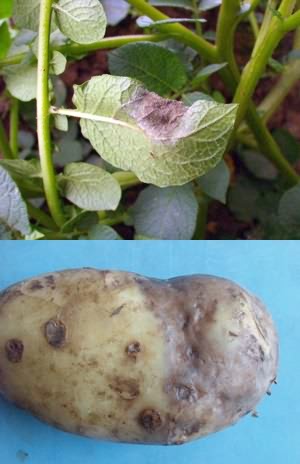Diseases
Phytophthora infestans (Mont.) de Bary - Potato Late Blight.
Systematic position.
Class Oomycetes, order Peronosporales, family Phytophthoraceae, genus Phytophthora.Biological group.
Obligate pathogen.Symptoms of disease and biology of pathogen.
P. infestans affects the leaves, stems and potato tubers. Symptoms appear at first as water-soaked spots, usually at the edges of the lower leaves. In moist weather the spots enlarge rapidly and form brown, blighted areas with indefinite borders. High humidity favors the appearance of white aerial mycelium on the undersides of the leaves. On stems the symptoms of disease develop as dark brown spots, and the stems break off. On potato tubers the Late Blight develops as purplish or brownish blotches consisting of water-soaked, dark, somewhat reddish brown tissue that extends into the flesh of the tuber. In their life cycle the fungi have two stages, asexual and sexual. In asexual stage the mycelium produces branched sporangiophores with lemon-shaped sporangia at their tips. Sporangia germinate in water on leaf surface and produce motile zoospores that are biflagellate. They move in water, then lose flagellums, form cell wall (encyst) and develop germ tubes penetrating into plant tissue, where multinuclear nonseptate mycelium develop. The type of sporangia germination is governed by environmental conditions, especially by temperature. The sporangia release zoospores at low temperatures (4. . 12.C), but they germinate by producing a germ tube at higher temperatures (20. . 27.C). The spores are washed from top, then they penetrate into soil and infect tubers. In sexual stage P. infestans have two mating types designated as A1 and A2. It can undergo sexual reproduction if only mycelia of both mating types are present in a population. Mycelia of both mating types differentiate anteridia and oogonia. When the anteridia and oogonia of different mating types fuse, the oospores are formed. They are covered with hard thick wall and can survive long in the soil in the absence of a host plant. After winter the oospores germinate by a germ tube that produces a sporangium.Distribution.
The Late Blight disease of potato is found in all areas where potatoes are grown. However, the damage of the disease depends on climatic and soil conditions. The South of the former USSR (Uzbekistan, Turkmenistan, Tajikistan, Georgia, and Azerbaijan) is a zone of low development of the disease (about 20% of affected tops). Central and Black Earth areas of Russia and the North Caucasus are the zones of moderate development of the disease (20-50% affected tops). The North West of Russia, the Ural, Siberia and especially the Far East is characterized by high damage (more than 50% of affected tops) of the disease.Ecology.
The development of the Late Blight epidemics depends greatly on the prevailing humidity and temperature during the different stages of the life cycle of the fungus. Late blight may cause total destruction of all plants in a field within a week or two, when the whether is cool and wet. The fungus grows and sporulates most abundantly at relative humidity near 100% and temperature between 15 and 25.C.Economic significance.
Potato Late Blight is one of the most devastating diseases in human history. Besides potato the Late Blight is also very destructive to tomatoes. Late Blight of potato can be controlled by combination of sanitary measures, resistant varieties, and well-timed chemical sprays. Fungicides used for the Late Blight control include Mancozeb.Related references:
Chumakov A.E., Zakharova T.I. 1990. Damage of agricultural plant diseases. Moscow: Agropromizdat, 126 p. (in Russian).Dudka I.A., Burdyukova L.I. 1996. Flora Fungorum Ukrainicae. Oomycetes. Phytophthoraceae, Albuginaceae. Kiev: Naukova Dumka, 204 p. (in Russian).
Popkova K.V. 1972. Potato Late Blight. Moscow: Kolos, 175 p. (in Russian).
Zakharenko V.A. 2003. Tendencies to the alteration of complexes of species, varieties of intrapopulation structures and dynamics of harmful organisms. Moscow, 31 p. (in Russian).
© Spiglazova S.U., Levitin M.M.


